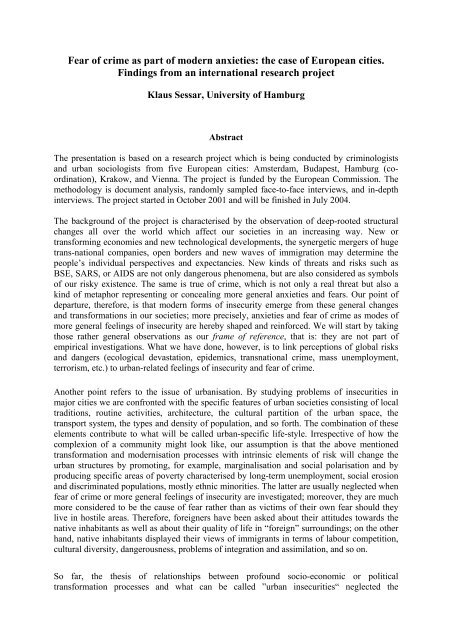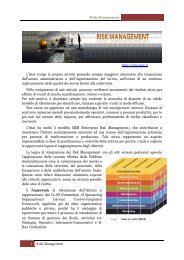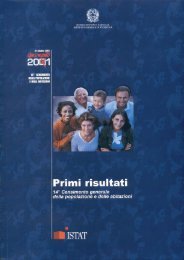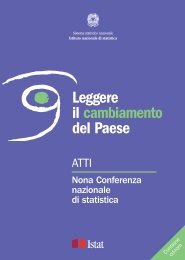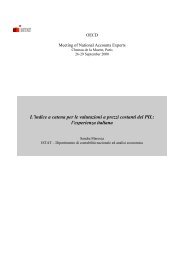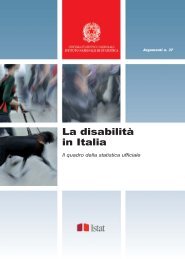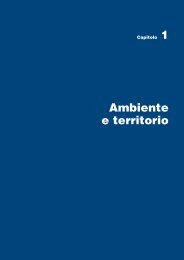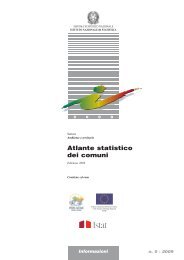Fear of crime as part of modern anxieties: the case of ... - Istat.it
Fear of crime as part of modern anxieties: the case of ... - Istat.it
Fear of crime as part of modern anxieties: the case of ... - Istat.it
You also want an ePaper? Increase the reach of your titles
YUMPU automatically turns print PDFs into web optimized ePapers that Google loves.
<strong>Fear</strong> <strong>of</strong> <strong>crime</strong> <strong>as</strong> <strong>part</strong> <strong>of</strong> <strong>modern</strong> <strong>anxieties</strong>: <strong>the</strong> c<strong>as</strong>e <strong>of</strong> European c<strong>it</strong>ies.Findings from an international research projectKlaus Sessar, Univers<strong>it</strong>y <strong>of</strong> HamburgAbstractThe presentation is b<strong>as</strong>ed on a research project which is being conducted by criminologistsand urban sociologists from five European c<strong>it</strong>ies: Amsterdam, Budapest, Hamburg (coordination),Krakow, and Vienna. The project is funded by <strong>the</strong> European Commission. Themethodology is document analysis, randomly sampled face-to-face interviews, and in-depthinterviews. The project started in October 2001 and will be finished in July 2004.The background <strong>of</strong> <strong>the</strong> project is characterised by <strong>the</strong> observation <strong>of</strong> deep-rooted structuralchanges all over <strong>the</strong> world which affect our societies in an incre<strong>as</strong>ing way. New ortransforming economies and new technological developments, <strong>the</strong> synergetic mergers <strong>of</strong> hugetrans-national companies, open borders and new waves <strong>of</strong> immigration may determine <strong>the</strong>people’s individual perspectives and expectancies. New kinds <strong>of</strong> threats and risks such <strong>as</strong>BSE, SARS, or AIDS are not only dangerous phenomena, but are also considered <strong>as</strong> symbols<strong>of</strong> our risky existence. The same is true <strong>of</strong> <strong>crime</strong>, which is not only a real threat but also akind <strong>of</strong> metaphor representing or concealing more general <strong>anxieties</strong> and fears. Our point <strong>of</strong>de<strong>part</strong>ure, <strong>the</strong>refore, is that <strong>modern</strong> forms <strong>of</strong> insecur<strong>it</strong>y emerge from <strong>the</strong>se general changesand transformations in our societies; more precisely, <strong>anxieties</strong> and fear <strong>of</strong> <strong>crime</strong> <strong>as</strong> modes <strong>of</strong>more general feelings <strong>of</strong> insecur<strong>it</strong>y are hereby shaped and reinforced. We will start by takingthose ra<strong>the</strong>r general observations <strong>as</strong> our frame <strong>of</strong> reference, that is: <strong>the</strong>y are not <strong>part</strong> <strong>of</strong>empirical investigations. What we have done, however, is to link perceptions <strong>of</strong> global risksand dangers (ecological dev<strong>as</strong>tation, epidemics, transnational <strong>crime</strong>, m<strong>as</strong>s unemployment,terrorism, etc.) to urban-related feelings <strong>of</strong> insecur<strong>it</strong>y and fear <strong>of</strong> <strong>crime</strong>.Ano<strong>the</strong>r point refers to <strong>the</strong> issue <strong>of</strong> urbanisation. By studying problems <strong>of</strong> insecur<strong>it</strong>ies inmajor c<strong>it</strong>ies we are confronted w<strong>it</strong>h <strong>the</strong> specific features <strong>of</strong> urban societies consisting <strong>of</strong> localtrad<strong>it</strong>ions, routine activ<strong>it</strong>ies, arch<strong>it</strong>ecture, <strong>the</strong> cultural <strong>part</strong><strong>it</strong>ion <strong>of</strong> <strong>the</strong> urban space, <strong>the</strong>transport system, <strong>the</strong> types and dens<strong>it</strong>y <strong>of</strong> population, and so forth. The combination <strong>of</strong> <strong>the</strong>seelements contribute to what will be called urban-specific life-style. Irrespective <strong>of</strong> how <strong>the</strong>complexion <strong>of</strong> a commun<strong>it</strong>y might look like, our <strong>as</strong>sumption is that <strong>the</strong> above mentionedtransformation and <strong>modern</strong>isation processes w<strong>it</strong>h intrinsic elements <strong>of</strong> risk will change <strong>the</strong>urban structures by promoting, for example, marginalisation and social polarisation and byproducing specific are<strong>as</strong> <strong>of</strong> poverty characterised by long-term unemployment, social erosionand discriminated populations, mostly ethnic minor<strong>it</strong>ies. The latter are usually neglected whenfear <strong>of</strong> <strong>crime</strong> or more general feelings <strong>of</strong> insecur<strong>it</strong>y are investigated; moreover, <strong>the</strong>y are muchmore considered to be <strong>the</strong> cause <strong>of</strong> fear ra<strong>the</strong>r than <strong>as</strong> victims <strong>of</strong> <strong>the</strong>ir own fear should <strong>the</strong>ylive in hostile are<strong>as</strong>. Therefore, foreigners have been <strong>as</strong>ked about <strong>the</strong>ir att<strong>it</strong>udes towards <strong>the</strong>native inhab<strong>it</strong>ants <strong>as</strong> well <strong>as</strong> about <strong>the</strong>ir qual<strong>it</strong>y <strong>of</strong> life in “foreign” surroundings; on <strong>the</strong> o<strong>the</strong>rhand, native inhab<strong>it</strong>ants displayed <strong>the</strong>ir views <strong>of</strong> immigrants in terms <strong>of</strong> labour compet<strong>it</strong>ion,cultural divers<strong>it</strong>y, dangerousness, problems <strong>of</strong> integration and <strong>as</strong>similation, and so on.So far, <strong>the</strong> <strong>the</strong>sis <strong>of</strong> relationships between pr<strong>of</strong>ound socio-economic or pol<strong>it</strong>icaltransformation processes and what can be called ”urban insecur<strong>it</strong>ies“ neglected <strong>the</strong>
individual<strong>it</strong>y <strong>of</strong> <strong>the</strong> selected c<strong>it</strong>ies. Each <strong>of</strong> <strong>the</strong>m h<strong>as</strong> <strong>it</strong>s own specific socio-cultural andtrad<strong>it</strong>ional characteristics (including socio-spatial factors), “<strong>it</strong>s own soul”, which makes <strong>it</strong>unique. Thus, <strong>it</strong> is <strong>as</strong>sumed, and is an essential <strong>part</strong> <strong>of</strong> our research design, that <strong>the</strong> c<strong>it</strong>ies (<strong>the</strong>residents and <strong>the</strong> policy-makers) produce ra<strong>the</strong>r different methods and qual<strong>it</strong>ies <strong>of</strong> observing,<strong>as</strong>sessing and coping w<strong>it</strong>h risks, insecur<strong>it</strong>ies and <strong>anxieties</strong>. This is especially true for Westernc<strong>it</strong>ies on <strong>the</strong> one hand, and c<strong>it</strong>ies from <strong>the</strong> former E<strong>as</strong>tern bloc on <strong>the</strong> o<strong>the</strong>r hand. Therefore,<strong>the</strong> study should give us essential clues to <strong>the</strong> social and cultural divers<strong>it</strong>y <strong>of</strong> European c<strong>it</strong>ies,both in terms <strong>of</strong> <strong>the</strong> awareness, closeness and intens<strong>it</strong>y <strong>of</strong> risks and dangers, <strong>the</strong> development<strong>of</strong> fear <strong>of</strong> <strong>crime</strong> and <strong>the</strong> ways <strong>of</strong> coping w<strong>it</strong>h <strong>it</strong>. Therefore, we expect to meet differentcultures <strong>of</strong> insecur<strong>it</strong>ies in <strong>the</strong> five c<strong>it</strong>ies <strong>as</strong> well <strong>as</strong> different cultures <strong>of</strong> handling <strong>the</strong>m. Thosedimensions are <strong>part</strong> <strong>of</strong> <strong>the</strong> comparative approach <strong>of</strong> <strong>the</strong> project. The numerous difficulties <strong>of</strong>such an enterprise have not been neglected. They have, among o<strong>the</strong>r things, to do w<strong>it</strong>hdifferences <strong>of</strong> <strong>the</strong> legal, social, and administrative systems, w<strong>it</strong>h different communal (andnational) governance-structures, but especially w<strong>it</strong>h <strong>the</strong> unequal chances <strong>of</strong> <strong>modern</strong>isationowing to <strong>the</strong> Iron Curtain. But <strong>the</strong>se differences are also <strong>the</strong> main challenge <strong>of</strong> such a study <strong>as</strong><strong>the</strong>y allow to yield more forceful generalisations when <strong>it</strong> comes to developing problemorientatedcoping strategies w<strong>it</strong>h respect to insecur<strong>it</strong>ies, <strong>anxieties</strong> and fear.The method is a three-step design consisting <strong>of</strong> a macro-level (<strong>the</strong> c<strong>it</strong>y), a meso-level (<strong>the</strong>district) and a micro-level (<strong>the</strong> neighborhood). These three spatial dimensions are investigatedby employing different methods. For <strong>the</strong> c<strong>it</strong>y, a “problem pr<strong>of</strong>ile” w<strong>as</strong> developed w<strong>it</strong>h <strong>the</strong>help <strong>of</strong> <strong>of</strong>ficial data and by interviewing “c<strong>it</strong>y experts”. From <strong>the</strong>re, two districts w<strong>it</strong>h severesocial problems were selected (e.g. high rates <strong>of</strong> unemployment, ethnic conflicts). In <strong>the</strong>sedistricts face-to-face interviews w<strong>it</strong>h randomly selected respondents were carried out (approx.500 interviews in every district). The questionnaire w<strong>as</strong> standardised in a way that makescomparisons between <strong>the</strong> c<strong>it</strong>ies for most <strong>of</strong> <strong>the</strong> variables possible. It w<strong>as</strong> developed in Germanw<strong>it</strong>h <strong>the</strong> <strong>part</strong>icipation <strong>of</strong> all <strong>part</strong>ners and <strong>the</strong>n translated into Polish, Hungarian, Dutch, andTurkish. (An English translation also exists, so that we were able to give <strong>the</strong> EuropeanCommission and <strong>the</strong> International Advisory Board evidence <strong>of</strong> our research efforts. It is notused in <strong>the</strong> field but is wa<strong>it</strong>ing to be applied by o<strong>the</strong>r <strong>part</strong>ners from <strong>the</strong> English-speakingworld in order to extend and enrich our project: www.insec.uni-hamburg.de). Finally, about50 to 70 in-depth-interviews w<strong>it</strong>h respondents from <strong>the</strong> surveys are on <strong>the</strong> way to beingaccomplished on a neighborhood level in each c<strong>it</strong>y, in order to learn more about <strong>the</strong>ir lifeworldand <strong>the</strong>ir general and special fears and <strong>anxieties</strong>, especially how <strong>the</strong>y perceive and useor avoid <strong>the</strong> urban space in view <strong>of</strong> risks and dangers. It is expected (and is <strong>part</strong> <strong>of</strong> <strong>the</strong>research design) that surveys from <strong>the</strong> interviews followed by in-depth-interviews w<strong>it</strong>h <strong>the</strong>same respondents will be complementary to each o<strong>the</strong>r in such a way that more pr<strong>of</strong>oundinformation and insights can be ga<strong>the</strong>red, than through <strong>the</strong> isolated use <strong>of</strong> each <strong>of</strong> <strong>the</strong>instruments.In a way one can say that we are studying <strong>the</strong> c<strong>it</strong>y (more precisely: some districts <strong>of</strong> <strong>the</strong> c<strong>it</strong>y)by using <strong>the</strong> att<strong>it</strong>udes <strong>of</strong> <strong>the</strong>ir c<strong>it</strong>izens like gl<strong>as</strong>ses through which we observe <strong>the</strong> deficiencies<strong>of</strong> <strong>the</strong> c<strong>it</strong>ies in regard to <strong>the</strong> safety <strong>of</strong> <strong>the</strong>ir c<strong>it</strong>izens.The presentation is mainly b<strong>as</strong>ed on <strong>the</strong> survey <strong>part</strong> <strong>of</strong> <strong>the</strong> project. It gives an overview <strong>of</strong>some cross-cultural phenomena in terms <strong>of</strong> <strong>the</strong> respondents’ perception <strong>of</strong> global risks anddangers and <strong>the</strong> way in which <strong>the</strong>y are afraid <strong>of</strong> <strong>crime</strong> or o<strong>the</strong>r problems which may affect<strong>the</strong>ir qual<strong>it</strong>y <strong>of</strong> life. In a second step, some empirical results, again w<strong>it</strong>h respect to <strong>the</strong> issues<strong>of</strong> fear and insecur<strong>it</strong>y, from one district in <strong>the</strong> c<strong>it</strong>y <strong>of</strong> Hamburg (Wilhelmsburg) will bedisplayed. This district h<strong>as</strong> a 40% population <strong>of</strong> mostly Turkish people; <strong>the</strong>refore, remarkabledifferences <strong>of</strong> <strong>the</strong> att<strong>it</strong>udes between <strong>the</strong>m and <strong>the</strong> German inhab<strong>it</strong>ants should be expected.


